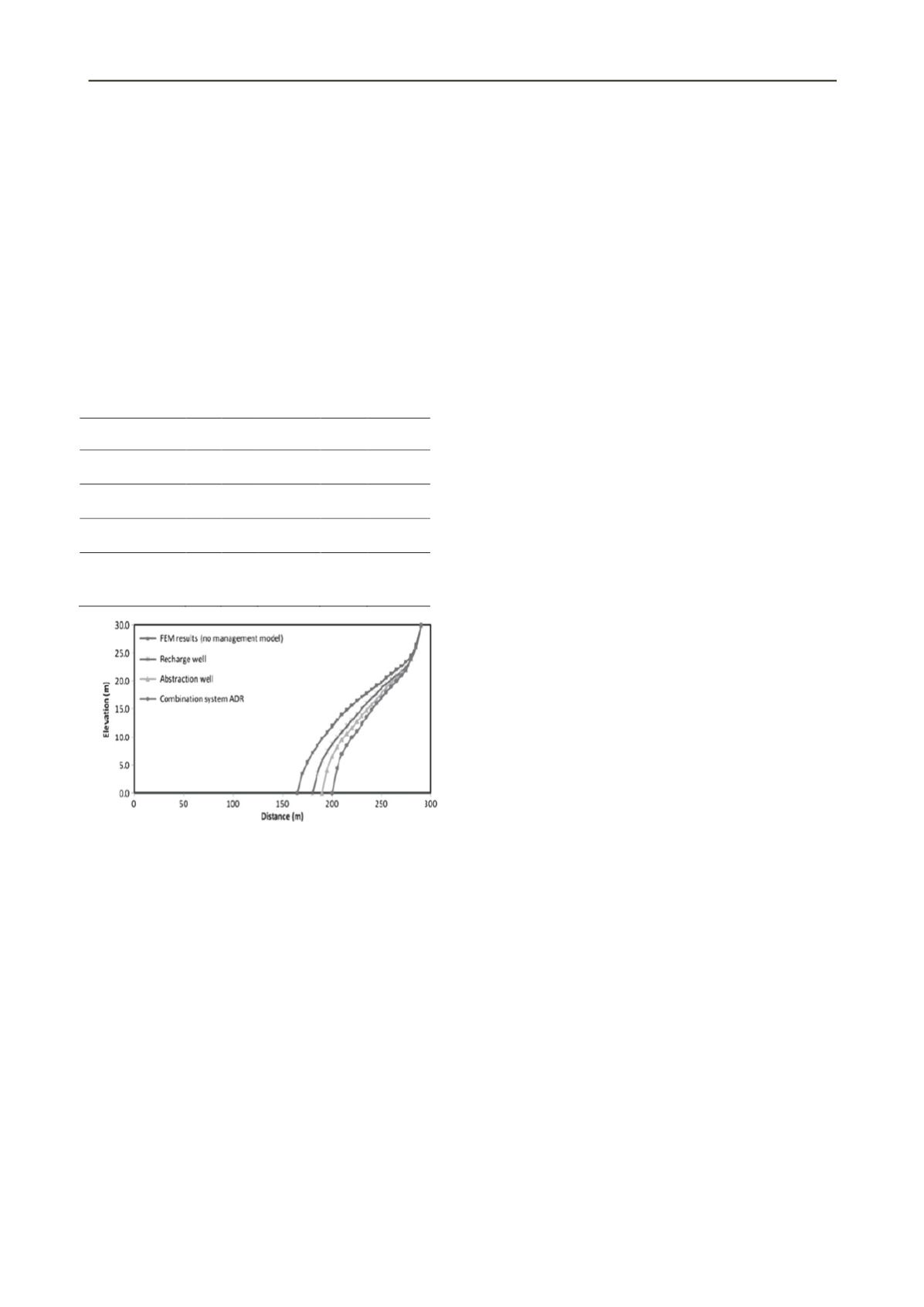
742
Proceedings of the 18
th
International Conference on Soil Mechanics and Geotechnical Engineering, Paris 2013
management model is the most cost effective strategy to control
the seawater intrusion in this hypothetical aquifer. The cost of
this model is about 50% of the abstraction only scenario and
25% of the recharge scenario. The reason for this lowest cost is
partly because the cost associated with the supply of water used
for recharge does not apply in this case as the required water is
provided primarily from the treatment of the abstracted saline
water. In addition, the excess treated water can be directly used
for other purposes. The other aspect of efficiency of this model
is about minimization of total concentration of salinity in the
aquifer as it reduced the total concentration in the system by
15% , while the first and second scenarios reduced it by 10-
11%. Figure (4) clearly shows the capability of third model in
controlling the further advance of the freshwater/seawater
interface in comparison with other models.
Table 2. Summary of the results obtained from the simulation-
optimization models for the hypothetical case study.
Figure 4. 0.5 isochlors from simulation-optimization models for the
hypothetical case.
6 CONCLUSIONS
This paper presented the development and application of a
simulation-optimization model to control seawater intrusion in
coastal aquifers. A coupled transient density-dependent finite
element model was used to simulate the seawater intrusion
problem. This simulation model was linked with a genetic
algorithm to optimize control arrangements for a hypothetical
aquifer using three management scenarios: abstraction of
brackish water, recharge of fresh water, and combination of
abstraction and recharge. The efficiencies of the proposed
management scenarios in controlling seawater intrusion in terms
of both the solute concentration in the aquifer and the total costs
(of construction and operation) of the management policy were
evaluated using this integrated model. The optimal locations,
depths, and rates of abstraction and/or recharge wells in each
scenario were determined. The results show that all three
scenarios could be effective in controlling sea intrusion but
using model 3 (a combination of abstraction and recharge wells)
resulted in the least cost and salt concentration in aquifers and
maximum movement of freshwater/saline water interface
towards the sea. The results also show that for the case study
considered in this paper, the amount of abstracted and treated
water is three times the amount required for recharge; therefore,
the remaining treated water can be used directly for different
purposes. Finally, ADR is an effective tool to control seawater
intrusion and can be applied in areas where there is a risk of
seawater intrusion.
7 REFERENCES
Abd-Elhamid H.F. and Javadi A.A. 2011. A density-dependant finite
element model for analysis of saltwater intrusion in coastal
aquifers,
Journal of Hydrology
401( 3-4), 259-271.
Cedeno W. and Vemuri V. R. 1996. Genetic algorithms in aquifer
management.
Journal of Network and Computer Applications
19
(2), 171–187.
Dhar A. and Datta B. 2009. Saltwater intrusion management of coastal
aquifers-I: linked simulation-optimization.
Journal of Hydrologic
Engineering
14(12), 1263-1272.
EL-Ghandour H. A., EL-Gamal M. A., Saafan T. A., Abdel-Gawad H.
A. 2008. Optimal management of saltwater intrusion in coastal
aquifers using genetic algorithm technique.
Proceeding of 12th
International Water Technology Conference (IWTC12)
,
Alexandria-Egypt, 1317-1343.
Eusuff M. M. and Lansey K. E. 2004. Optimal operation of artificial
groundwater recharge systems considering water quality
transformations.
Water Resources Management Journal
18, 379–
405.
Gordu F., Yurtal R. and Motz L.H. 2001. Optimization of groundwater
use in the Goksu delta at Silifke.
First International Conference on
Saltwater Intrusion and Coastal Aquifers Monitoring, Modeling,
and Management (SWICA-M3),
Essaouira, Morocco, Turkey, 1-10.
Henry H. R. 1964. Effects of dispersion on salt encroachment in coastal
aquifers. Seawater in coastal aquifers,
US Geological Survey Water
Supply Pap
, 1613-C. 70–84.
Lee C.H. and Cheng R.T. 1974. On seawater encroachment in coastal
aquifers.
Water Resources Research
10(5), 1039-1043.
Mahesha A. 1996. Transient effect of battery of injection wells on
seawater intrusion.
Journal of hydraulic engineering
122(5), 266–
271.
Park C. H. and Aral M. M. 2004. Multi-objective optimization of
pumping rates and well placement in coastal aquifers.
Journal of
Hydrology
290(1-2), 80-99.
Pinder G. F. and Cooper H. H. 1970. A numerical technique for
calculating the transient position of the saltwater front.
Water
Resources Research
6(3), 875-882.
Qahman K. and Larabi A. 2006. Evaluation and numerical modeling of
seawater intrusion in the Gaza aquifer (Palestine).
Hydrology
Journal
14(5), 713-728.
Qahman K., Larabi A., Ouazar D., Naji A. and Cheng A.H.D.
2009. Optimal extraction of groundwater in Gaza coastal aquifer.
Journal of Water Resource and Protection
4, 249-259.
Rastogi A. K., Choi G.W. and Ukarande S.K. 2004. Diffused interface
model to prevent ingress of seawater in multi-layer coastal aquifers.
Journal of special hydrology
4(2), 1–31.
Sivanandam S. N. and Deepa S. N. 2008.
Introduction to genetic
algorithms
. Springer-Verlag, New York.
Sreekanth J. and Datta B. 2010. Multi-objective management of
saltwater intrusion in coastal aquifers using genetic programming
and modular neural network based surrogate models.
Journal of
Hydrology
393(3-4), 245-256.
Todd D. K. 1974. Salt-water intrusion and its control.
Water technology/
resources. Journal of American Water Works Association
66 (3),
180-187.
Model
L
(m)
D
(m)
Q
(m
3
/sec)
Total
C
Cost
($/year)
No
Management
-
-
-
167
-
Abstraction only
50
90
-0.083
149
2.62E+6
Recharge only
90
60
0.095
151
5.72E+6
Abstraction
and
Recharge
50
110
90
80
-0.048
0.018
142
1.32E+6


